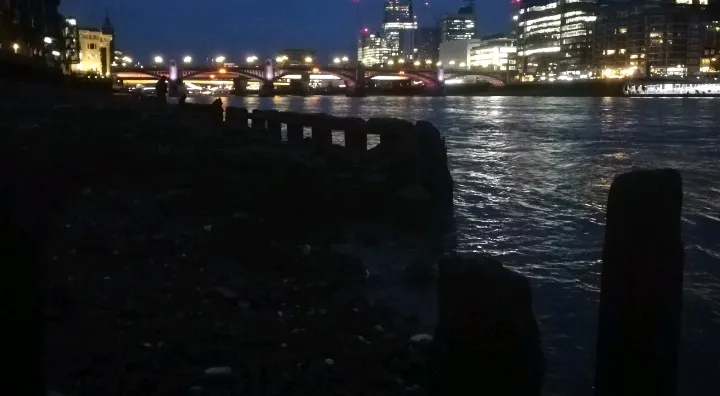The Hag Stone
⬇️ German translation see below.
The Thames was at low tide. Right by the Millennium Bridge there was an opportunity to climb deep down the steps to the river bank. Between St. Paul's, where that old woman fed the pigeons in 'Mary Poppins', and the Tate Gallery, which I love so much. Besides me there were two other people walking in the dark, using headlamps to search for things that might be of value. Other than that, the riverbank was very empty that evening.
Sure enough, in the darkness I found a striking stone that measured about 2 inches. Bizarrely shaped with a half-inch hole in its middle. Such stones are also called hag stones or snake's eggs. The Celts also called them Druid stones, and on the Baltic Sea they were called chicken gods ("Hühnergötter"). Chicken gods are actually protective lucky charms, right? — So I put the stone in my pocket.
At home I noticed that some edges had broken off the stone. There was a porous structure inside. The stone was beautifully shaped and polished smooth by the water. With some nice scratch marks. But the porous structure reminded me of something else: a bone. Was it a fossilized animal bone? It must have been a larger animal. Or was it perhaps a human...
The Thames was at low tide. Right by the Millennium Bridge there was an opportunity to climb deep down the steps to the river bank. Between St. Paul's, where that old woman fed the pigeons in 'Mary Poppins', and the Tate Gallery, which I love so much. Besides me there were two other people walking in the dark, using headlamps to search for things that might be of value. Other than that, the riverbank was very empty that evening.
Sure enough, in the darkness I found a striking stone that measured about 2 inches. Bizarrely shaped with a half-inch hole in its middle. Such stones are also called hag stones or snake's eggs. The Celts also called them Druid stones, and on the Baltic Sea they were called chicken gods ("Hühnergötter"). Chicken gods are actually protective lucky charms, right? — So I put the stone in my pocket.
At home I noticed that some edges had broken off the stone. There was a porous structure inside. The stone was beautifully shaped and polished smooth by the water. With some nice scratch marks. But the porous structure reminded me of something else: a bone. Was it a fossilized animal bone? It must have been a larger animal. Or was it perhaps a human...




